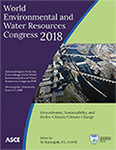World Environmental and Water Resources Congress 2018
Prediction of Runoff Using Distributed Physics Based Hydrological Model in Burhanpur Catchment, India
Publication: World Environmental and Water Resources Congress 2018: Groundwater, Sustainability, and Hydro-Climate/Climate Change
ABSTRACT
Mesoscale hydrological models are required for suitable assessment for prediction of runoff in larger catchments. The objective of present study is to evaluate the performance 2D MIKE SHE model coupled with MIKE SHE/MIKE 11 including the overland flow and channel flow processes in Burhanpur catchment (area of 8995 km2), part of Upper Tapi Basin, India. The Shuttle Radar Topographic Mission (SRTM) Digital Elevation Model (DEM) 30 m topographical data, gridded rainfall (0.250×0.250) data, station based potential evapotranspiration (PET) and IRS P6 LISS-III satellite data of year 2000 (used for land use classification) were taken as distributed input into the model. The model parameters were calibrated on grid size 500 m×500 m using stream flow data of flood year 1994, and further, validated for independent data of flood years 1998 and 2007. The model performance was quantitatively assessed using statistical indicators, RMSE (=168.3– 175.7 m3/s and 20.5–15.9 mm), NSE (=0.69–0.68 and 0.89–0.87), and r (=0.78–0.77 and 0.96–0.94) on daily as well as monthly time scales respectively, during calibration and validation periods. The calibrated model would be useful for prediction of runoff and stage along Tapi River at Hathnur Dam, India.
Get full access to this chapter
View all available purchase options and get full access to this chapter.
ACKNOWLEDGEMENT
Authors are thankful to MHRD-NPIU-TEQIP-II for providing the funding through a Centre of Excellence (COE) Project on ‘Water Resources and Flood Management’ at SVNIT Surat under which present investigation was undertaken.
REFERENCES
Chow, V.T., Maidment, D. R., and Mays, L. W. (1988). Applied Hydrology. Mcgraw Hill, New York.
Dai, Z., Li, C., Trettin, C., Sun, G., Amatya, D., and Li, H. (2010). Bi-criteria evaluation of the MIKE SHE model for a forested watershed on the South Carolina coastal plain. Hydrologic Earth System Sciences, 14, 1033–1046.
DHI. (2017). MIKE SHE reference manual. MIKE by DHI, Denmark.
Engman, E. T. (1986). Roughness coefficients for routing surface runoff. Journal of Irrigation Drainage Engineering, 112(1), 39–53.
Kaarlsson, I. B., Sonnenborg, T. O., Refsgaard, J. C., Trolle, D., Borgesen, C. D., Olesen, J. E., Jeppesen, E., and Jensen, K. H. (2016). “Combined effects of climate models, hydrological model structures and land use scenarios on hydrological impacts of climate change.” Journal of Hydrology, Vol. 535, pp. 301–317.
Henriksen, H. J., Troldborg, L., Nyegaard, P., Sonneborg, T. O., Refsgaard, J. C., and Madsen, B. (2003). Methodology for construction, calibration and validation of a national hydrological model for Denmark. Journal of Hydrology, 280, pp. 52–71.
Kothyari, U. C., Raamsankaran, Raaj, Satish Kumar, D., Ghosh, S. K., and Mendiratta, N. (2010). Geospatial based automated watershed modeling in Garhwal Himalaya. Journal of Hydroinformatics, 12(4), 502–520.
Madsen, H. (2003). Parameter estimation in distributed hydrological catchment modelling using automatic calibration with multiple objectives. Advances in Water Resources, 26(2), 205–216.
Qin, H., Cao, G., Kristensen, M., Refsgaard, J. C., Rasmussen, M. O., He, X., Liu, J., Shu, Y., and Zheng, C. (2013). Integrated hydrological modeling of the Norh China Plain and implications for sustainable water management. Hydrologic Earth System Sciences, 17, 3759–3778.
Rawls, W. J., and Brakensiek, D. L. (1989). Estimation of soil water retention and hydraulic properties. In: Morel-Seytoux (ed.), Unsaturated flow in hydrologic modeling: Theory and practice. Kluwer Academic Publisher, Boston, 275–300.
Singh, R., K. Subramanian, and J.C. Refsgaard. (1999). “Hydrological modeling of a small watershed using MIKE SHE for irrigation planning.” Agricultural Water Management, Vol. 41(3), pp. 149–166.
Thompson, J. R., Sorenson, H. R., Gavin, H., and Refsgaard, A. (2004). “Application of the coupled MIKE SHE/MIKE 11 modelling system to a lowland wet grassland in southeast England.” Journal of Hydrology, Vol. 293, pp. 151–179.
Vieux, B. E. (2001). Distributed hydrologic modeling using GIS. Kluwer Academic Publishers, Dordrecht, The Netherlands.
Wijesekara, G. N., Farjad, B., Gupta, A., Qiao, Y., Delaney, P., and Marceau, D. J. (2014). “A Comprehensive Land-Use/Hydrological Modeling System for Scenario Simulations in the Elbow River Watershed, Alberta, Canada.” Environmental Management, Vol. 53, pp. 357–381.
Yan, J., and Smith, K.R. (1994). “Simulations of integrated surface water and ground water systems – model formulation”, Water resources bulletin, American Water Resources Association,Vol. 30(5), pp. 879–890.
Information & Authors
Information
Published In
World Environmental and Water Resources Congress 2018: Groundwater, Sustainability, and Hydro-Climate/Climate Change
Pages: 323 - 333
Editor: Sri Kamojjala, Las Vegas Valley Water District
ISBN (Online): 978-0-7844-8141-7
Copyright
© 2018 American Society of Civil Engineers.
History
Published online: May 31, 2018
Authors
Metrics & Citations
Metrics
Citations
Download citation
If you have the appropriate software installed, you can download article citation data to the citation manager of your choice. Simply select your manager software from the list below and click Download.
